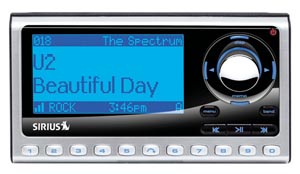 I’ve had a subscription to sirius satellite radio for the last four months and I can’t say enough good things about it. The best thing about it, besides the lack of commercial interruptions and music selection, is that with the online streaming, you don’t really need to purchase a sirius radio as long as you have an internet connection where you want to listen. This is the case for me.
I’ve had a subscription to sirius satellite radio for the last four months and I can’t say enough good things about it. The best thing about it, besides the lack of commercial interruptions and music selection, is that with the online streaming, you don’t really need to purchase a sirius radio as long as you have an internet connection where you want to listen. This is the case for me.
Over the the last few months I have been able to integrate sirius with MythTV, my Linux and Mac laptops, and now my Nokia N800 internet tablet.
Radio? We don’t need no stinking radio!
I would like to give credit for most of the grunt work to jtyrrell and m00s3computer of the internettablettalk.com forums. All I did was clean up their instructions and verify the procedure.
If you have an older N800 that’s still running OS2007, upgrade to OS2008. The instructions for upgrading your OS can be found here.
The first step to installing sipie on your N800/N810 is getting root access on your internet tablet. You have two choices. You can either enable R&D mode or use the SSH method to gain root privileges. This is required to install the necessary packages.
You can find the instructions for enabling R&D mode here.
To use the SSH method you have to enable the maemo Extras repository in your application manager.
You have to do this either way seeing we are going to install the dependencies for sipie from this repository.
ApplicationManager->Tools->Application catalogue…
Edit maemo Extras
Uncheck disabled box
Click OK and wait for the refresh
Once that is done, you can go back to the application manager and install openssh. You could also goto the maemo site and use the one click installer from your Nokia internet tablet.
During the install it will ask you to set a password. Once the install is complete you can open xterm (Utilities > Xterm) and type the following at the command line:
ssh root@localhost
Enter your password. You should now have root privileges.
If you chose to enable R&D mode you can open xterm (Utilities > Xterm) and enter the following at the command prompt:
sudo gainroot
Now that you have root privileges on our Nokia internet tablet, we can begin to install the dependencies for sipie.
At the command line enter the following:
apt-get install mplayer python2.5 python2.5-dev python2.5-setuptools wget
Next install the BeautifulSoup python extension by entering the following at the command line:
easy_install BeautifulSoup
Change to you home directory.
cd /home/user/MyDocs
Download sipie from this site. I made one change to the scripts from the default. I increased the mplayer buffer from 32 to 1024 in the cliPlayer.py script to avoid skipping. Other then that, there are no changes. I just created a tar archive so you could easily install sipie using wget.
wget http://packratstudios.com/download/sipie.tar.gz
Untar the archive by entering the following:
tar -xvzf sipie.tar.gz
Change to the sipie directory:
cd sipie
Launch sipie:
python sipie.py
At this point you will be prompted for a username and password for sirius, whether you are a subscriber or guest, your location, the stream you want to listen too, and the text of a captcha file used to verify you’re human . If you are not a subscriber then you can sign up for a free three day trial at sirius.com.
The stream is usually the name of the station you want to listen to. For example, thevault, atlnation, or octane. It is always lower case and if it is composed of two words there is normally, but not always, and underscore between the words. You’ll have to play around with name. You could get this from the windows player. The stream name is part of the URL, I believe.
By default the captcha file is saved to the root of your home directory. Unfortunately you can’t see this directory in the file manager. In order to view the image file, enter the following in a new xterm session. Don’t close the original xterm session.
Of course you’ll have to repeat the method you used to gain root access in this new xterm session but, once that is complete, enter the following to move the image file.
mv /home/user/img*.* /home/user/MyDocs
Once this is done you can goto the file manager and open the image file in the preview application. Once you have the text (yes it is case sensitive) you can return to your original xterm session and enter it. Thankfully, you only have to go through this process once.
If everything went right you should start hearing your stream after a few seconds.
To end the stream and change stations you have to enter Ctrl+C. You also have to do this to exit the application.
Someone let me know if there is a better way to do this. I haven’t tried entering exit or quit yet.
Enjoy…
